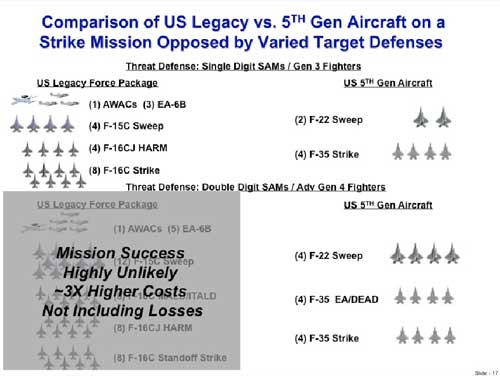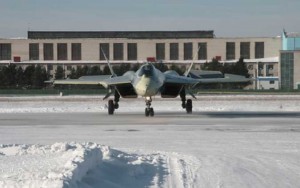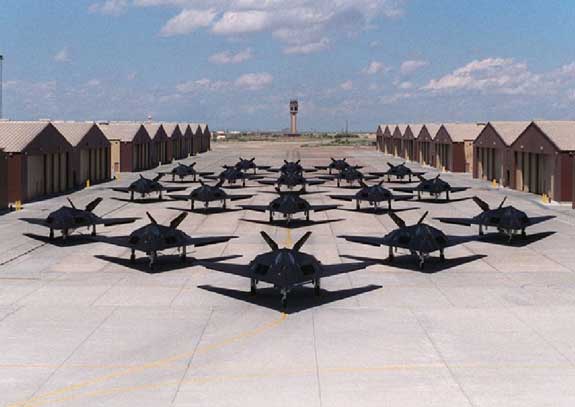“Re-norming” the Asymmetric Advantage in Air Dominance: “Going to War with the Air Force You Have” (Part One)
By Michael W. Wynne
21st Secretary of the U.S. Air Force
10/08/2010 – In this piece, Secretary Wynne identifies ways to leverage new technologies to “re-norm” air operations to assure U.S. and allied air dominance in the challenging period ahead. The piece will appear in three postings, this being the first. Upon the publication of the third, a special report containing the full presentation will be available for download to Second Line of Defense readers.
***
The F-117, which has been retired, was a key strike asset.
Credit photo: http://www.usafnukes.com
Secretary Rumsfeld, in one of his philosophic comments said, “You go to war with the Army you have; not the Army you want.” I would suggest a similar approach to understanding our capabilities for future concepts of air operations and making modifications to accommodate them.
A realistic look at the future of Air Operations must take into account the size of the force, the capabilities of the force and the evolving construct of the future weapons available; and then we can place against this template of available forces against what technologies would or could maximize their utility to a combatant commander. There has been steady erosion in the quantity of aircraft being made available to allied Air Forces around the world. For the past several generations of development, we have substituted combat qualities for enhanced quantities within each platform.
To deal with declining numbers (“quantity has a quality all of its own”) calls for imagination and innovation in thinking about future investments and concepts of joint operations. We need to leverage technology trends; and picking strategies that our ground combat commanders have used historically, to restore the unfair fight, and ensure that we have superiority at the point of the spear.
At the same time, we must focus on ways to minimize the probability for failure; while we maximize our probability of success. We may be longing for the days of large numbers of combat platforms, but now must consider where we are and what is the real, not desired trends affecting deployable capability.
We cannot rely on the ability to quickly accelerate our industrial capacity as we have done in the past. We must consider the fact that the speed of war has increased, and that the time necessary to field new technology marvels has increased. We must take to heart Secretary Rumsfeld’s comment and begin to design a future plan that allows for erosion in our “asymmetric” advantage.
To deal with declining numbers (“quantity has a quality all of its own”) calls for imagination and innovation in thinking about future investments and concepts of joint operations. We need to leverage technology trends; and picking strategies that our ground combat commanders have used historically, to restore the unfair fight, and ensure that we have superiority at the point of the spear. At the same time, we must focus on ways to minimize the probability for failure; while we maximize our probability of success. We may be longing for the days of large numbers of combat platforms, but now must consider where we are and what is the real, not desired trends affecting deployable capability. We cannot rely on the ability to quickly accelerate our industrial capacity as we have done in the past. We must consider the speed of war has increased, and the time necessary to field new technology marvels has increased.
Building such CONOPs is rooted in more data sharing and more integrated tactics. We need to reach into the ground commander’s kit; and consider shaping air versions of forward observers, weapons teams and spotters to assist with targeting; and to provide for layered offenses to match layered defenses.
In other words, as we shift from older notions of our capabilities for air superiority, how do we shape dominance on the battlefield? But what must be understood, as General Corley has forcefully underlined in his interview, is that, without air superiority, it is impossible for the joint warfighter to operate at all or effectively in projecting global power.
Realists point out that if you want to know the armed forces capability ten years hence, you must look around today. Even Germany’s Blitzkrieg capability was minimal in 1940; in many ways it was an aspiring template relative to the bulk of their deployed forces; some of which was still horse drawn and supplied. Indeed, if one looks carefully at Leni Riefenstahl’s masterpiece “The Triumph of the Will,” one sees as many horses as tanks in the propaganda film.
Unless actions are quickly taken, the structure of America’s capability to provide the kind of air dominance in a future fight will decline, even dramatically. And with this decline will come reduced freedom of action for our allies as well.
The size of the air arms of the U.S. forces is clearly going down. Current Air Force plans call for standing down 250 fourth generation tactical fighters as the transition to the complement of 185 F-22. This represents a total inventory and not an operational inventory that is closer to 150. Added to this are an emerging, but undetermined and as yet un-deployed, total of F-35 fighters.
Fifth generation air will slowly grow with deliveries and the Marines will push the AV8 out of their inventory as the STOVL F-35 sparks their imagination regarding CONOPS. Navy has asked to invest further into fourth generation fighters, as their F-35 CV version goes through the testing phase and they worry for the viability of their aging carrier Air Fleet and see the need to populate the carrier decks.
 Lt General Deptula’s depiction of the challenge to the offense posed by growing defensive capabilities.
Lt General Deptula’s depiction of the challenge to the offense posed by growing defensive capabilities.
Credit: Airpower Evolution briefing, April 14, 2010
Clearly, the resultant structure of U.S. airpower will be a mixed fleet of fifth generation and fourth generation fighter aircraft for an indefinite period. And several specialized capabilities central to past successes are eliminated or rapidly aging. Of the aircraft that the American military used to penetrate the air defenses in Iraq in 2003, the F-117 has been grounded and the B-2 continues to age with reduced capability to penetrate air defenses that are increasingly sophisticated. Adversary defenses have not remained static; integrated air defenses are now becoming much more effective and much more mobile. The strategic trajectory is to update defenses with regard both to range and maneuverability. Competitors have complemented these defenses with upgrades of their own air fleet using a mixture of calibrated 4.5 generation technologies.

Competitors are introducing near fifth generation capabilities, such as the new Russian fighters, and others are shaping new generation missiles for their own use and export. The Chinese will be able to project power simply by exporting missiles to various developing states and can certainly up the ante in any Middle East confrontation.
The mission concerning air dominance is unyielding and will continue to call on our brave pilots to hold hostage targets anywhere in the world: to do so requires an ability to penetrate integrated air defenses, and along the way to deter or defeat enemy air.
This puts CONOPS pressure on the other elements of the combat air force. The refuelers or tankers become essential to power projection. But they are not being replaced in a timely fashion. Other approaches may be necessary such as developing the concept of drop tanks for fifth generation aircraft as the sortie to the battle zone; thus allowing tankers added discretion. But compensating for missing tanker platforms by such means is not optimal.
We need to take a hardheaded look at what we have to execute the air dominance mission; and therefore complement the ability of the combatant commander to succeed by extending well into the 21st century America’s control of the skies. We cannot continue to assume a dominance which has been built by past investments, absent a robust engagement to shape capabilities for the future.
We need to look into the benefits of the current investment and the technologies, which are or can be brought to bear seriously to level the fight. I have a philosophy that if America is ever in a fair fight; we have suffered from bad planning. Though this stemmed from the clear asymmetric advantage that has been whittled away, coupled with the Clausewitzian advantage always granted to defenders. What then are the available platforms and technologies that we have invested in to date? And how can we shape effective Concepts of Operations for a Joint and Combined Air Strike Force, which leverage these capabilities?
We need to look into the benefits of the current investment and the technologies, which are or can be brought to bear seriously to level the fight. I have a philosophy that if America is ever in a fair fight; we have suffered from bad planning. Though this stemmed from the clear asymmetric advantage that has been whittled away, coupled with the Clausewitzian advantage always granted to defenders. What then are the available platforms and technologies that we have invested in to date? And how can we shape effective Concepts of Operations for a Joint and Combined Air Strike Force, which leverage these capabilities?


